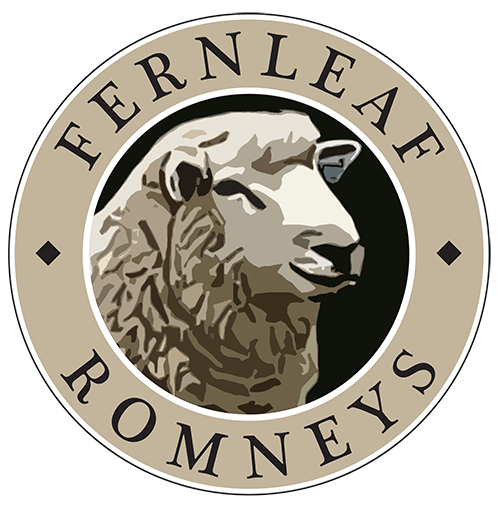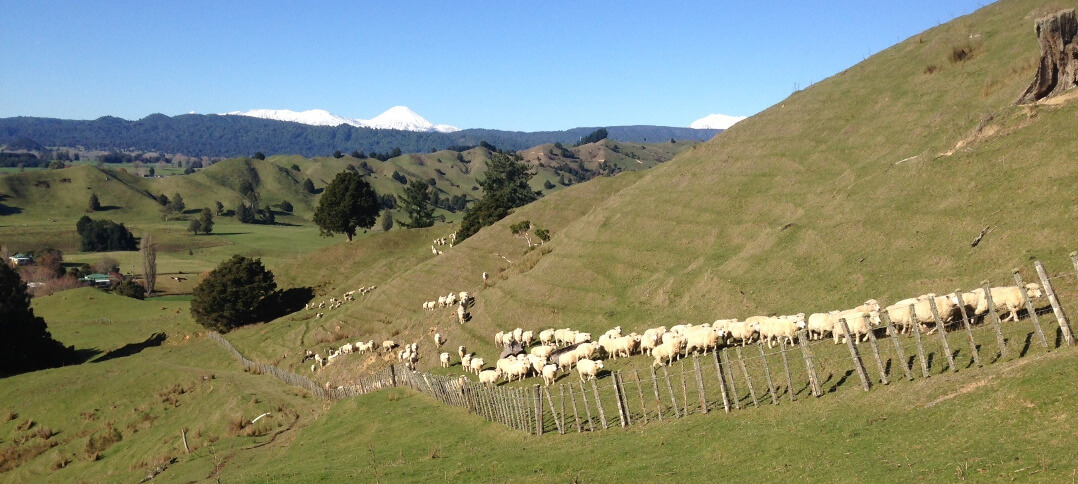Frequently Asked Questions
Question: How long has the Fernleaf Romney stud been Performance Recording?
Answer: The Fernleaf Romney stud has been operating for 100 years, and we were one of the founding members of the first National Flock Recording Scheme (NFRS) in 1967, and have been recording ever since as the scheme was updated to Sheeplan and then Animal Plan.
Question: What traits have you given most emphasis to over that time?
Answer: On our steep central North Island hill country with stocking rates of 16 SU/ha, we have put emphasis on fertility, survival, growth and wool. In the early days we had to put big emphasis on increased Facial Eczema (FE) tolerance, then improved lamb survival under our high Stocking Rate regime with dry summers. Fleece weight and quality have also been important goals over the history of the stud.
Question: Looking back over those decades, what pleases you most about the flock today?
Answer : It’s the simple fact that our sheep can stand up to real hill country conditions – regardless of the seasons. The past droughts have certainly proved this and more are forecast ahead. This gives us great confidence that Fernleaf Rams will do their job anywhere in New Zealand where sheep are challenged. We are pleased to find that clinical signs of FE in the flock are now rare, and 60% of our lambs get right through till May (eight months old) without the need for a worm drench, with our ram and ewe hoggets always showing a very high proportion with zero or low Faecal Egg Count (FEC), taken at the most challenging time of the spring larval rise.
Question: You have been breeding for Worm Resistance. How have you done this?
Answer:
- We first went out and sourced the best worm resistant sires available at the time, and then we started on an intense selection programme within the Fernleaf flock. It was a simple programme of extending drench times gradually, and not drenching sheep that didn’t need
- This is the new concept of ‘Refugia’ where you leave the drench‐tolerant worms in a ‘refuge’ and don’t kill them off.
- Research showed that a sheep’s ability to handle worm burdens has a genetic base, with a heritability factor of around 25% (which is high), so progress can be made if you have an effective selection programme to fix it. We have! In most seasons now, we regularly have 75‐80% of ram lambs totally undrenched going into winter.
- It’s all about allowing the lamb from birth through weaning up to the hogget stage to develop it’s own ‘genetic’ immunity – without overwhelming this natural process with ‘chemotherapy’ (anthelmintic drenches). We have encouraged this immune development with a mineral supplements as established research (from the time of Gladys Reid) showed this worked.
- We now base selection of all ram hoggets on Faecal Egg Count (FEC) and Faecal Consistency Score (FCS). We do the FEC at the most challenging time of the season during FAQ update, 2015 the autumn larval rise around March to May, and look for those animals with less than 100 worm eggs/gm of faeces. With FCS we give top ranking to ram hoggets producing FCS Grade 1 (‘marbles’).
- We base the selection of ewe hoggets on FCS ‐ Grades 1 (marbles) and 2 (hand grenades). It’s essential to take both FEC and FCS into account, as there is no merit in sheep with low worms and green scour.
- No ewe on the property gets an anthelmintic drench, and we are constantly on the lookout for any that may scour when the rest of the mob are clean. These are marked for early culling, and their offspring are noted too for the same fate.
Question: How do you know that this programme has worked?
Answer:
- By the simple fact that we have never had a major internal parasite crisis where we have had to resort to using anthelmintics. We have to be on the lookout for Barber’s Pole worms in certain seasons, and if this is a threat, we used a specific drench for BP. The key point is that as we have no worm resistance, an anthelmintic will do its job perfectly with no residual effects.
- Growth, especially in young sheep has improved, as has wool production from the flock in a challenging climatic environment with minimal chemotherapy.
Question: You have also been breeding to get rid of dags. Is that possible and how did you
do it?
Answer:
- There are many reasons why a sheep produces dags as they reflect issues with nutrition and efficiency of food conversion. But research has shown that this trait has a genetic base, with a heritability factory of around 25%, so progress can be made if you have an effective selection programme. To appreciate this, take a look at a stock camp and note all the different grades of FCS among sheep all treated the same. This variation must be genetic.
- We select all ram hoggets on the basis of Faecal Consistency Score (FCS). We want sheep that produce ‘marbles’ (Score 1) as they don’t stick to wool when the sheep daefecates standing, or during the night when she daefecates when resting. We will also accept sheep that produce FCS 2 (‘hand grenades’) but soft faeces are out.
Question: How do you know if your programme has worked?
Answer:
- Simply by the few dags that I now have to remove from our 800 stud ewes. I can remove all that’s needed with the sheep standing in the crush pens, and what comes off is hardly worth picking up. At most there are only two and a half barrow‐loads annually. It’s wonderful to know that I never have to face dragging sheep across the board any more, threatening my back, hips, knees and brain! There’s nobody now in the district silly enough to want to dag sheep any more – no matter what you offer to pay them. Even dagging sheep to pay for student loans has lost its appeal!
- The most satisfying sight is to see clean ewes with clean twins at times of lush feed when others may be showing light dags. It’s been pleasing to see how quickly you can make FAQ update, 2015 genetic gain in removing dags – genetics are certainly a lot more effective than a handpiece!
Question: But don’t any sheep get dirty at certain times of year, because of things like lush feed?
Answer: Yes they do, but they soon dry up. And even during times when sheep are loose due to spring flush or being on the crop, you still see sheep producing marbles when the rest have loose dungs. These are the genetics we are working on.
Question: What happened to ‘the Colonel’?
Answer: After a decade of genetic contribution to Fernleaf, he passed away quietly to leave his genes throughout the flock. He always had a zero FEC and produced marbles and hand grenades, regardless of when he was tested and what kind of diet he was on. We have semen on ice from him for the day when (and not if) some exotic disease arrives in New Zealand. Too few breeders have done this.
Question: What have you done to increase FE resistance?
Answer:
- Breeding for FE resistance has never been so important with all the concern over climate change. The disease certainly seems to be spreading. We were some of the first breeders to get involved in research dosing rams with the sporidesmin toxin isolated by Ruakura scientists in the 1970s, to identify rams that could stand a high dose of toxin (isolated from the fungus grown at Ruakura), which they would then pass it on to their offspring.
- This early work showed that our sheep had a good resistance even then, which was not surprising through our approach of using ‘survival of the fittest’ on FE prone country. Any sheep in those early days that got FE died, so their genes were automatically removed from the flock.
- So we have constantly used the ‘natural challenge’ over the whole flock, which occurs in most seasons in the Owhango area, and we bred from sheep that could handle this over the last 40 years, supported by rams brought in from flocks where sporidesmin toxin dosing had been used for 30+ years now.
- In the last two seasons we have used rams from studs where they have tested with up to 0.6mg sporidesmin to give our flock a boost, which is now built into our sale rams.
Question: Have you not used the Ramguard FE selection programme?
Answer: No, because we were happy with our own approach. There’s an increasing concern in future that the toxin dosing protocol will be stopped due to animal welfare concerns. Hopes are now being placed in finding the genetic markers involved.
Question: So can you get rid of dags, worms and FE all at the same time?
Answer : Yes, because there are no genetic or environmental conflicts between the traits. We have taken the approach that in Fernleaf we will deal with these traits separately and not build them into an overall index, as the more traits you add to an overall index like SIL’s DPO, the whole thing slows down and you’ll never see the benefits in your lifetime – FAQ update, 2015 realising that a sheep generation interval is 3 years.
Question. So how can I get the best from a purchased Fernleaf Ram?
Answers:
- First think in terms of ‘population genetics’ to give the flock a big initial genetic boost, which means improving the genes over your whole flock, and not just try to change things in one small part, as you’ll never see the improvement in your lifetime or reap the financial rewards.
- Then you need to think about using a ‘team of Fernleaf Rams’, to make a large and rapid impact on your flock mean performance. You won’t improve the flock mean by only adding a few new rams to your flock each year. You need to flood your flock with improver rams, and those down the Selection List will be ideal for the job – to put a sound performance foundation into your flock.The genetic gain from such rams will follow the genetic gain in the Fernleaf flock with a lag of two generations (6 years), so you need to get moving on your own breeding programme.
- Then sort out your best commercial ewes and raddle or better still tag them. Call them your ‘A‐Team’ and keep adding better ewes to them each year (e.g. from the 5‐year‐olds), and cull any that fail to perform.
- These A‐Team sheep are the ones you put your top purchased Fernleaf Rams to, so all their female offspring flood back into the main flock – and the best of them will end up in the A‐Team.

